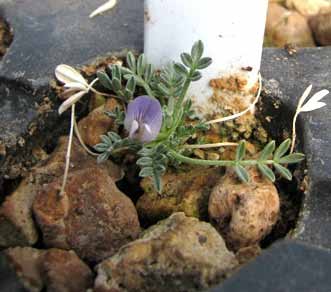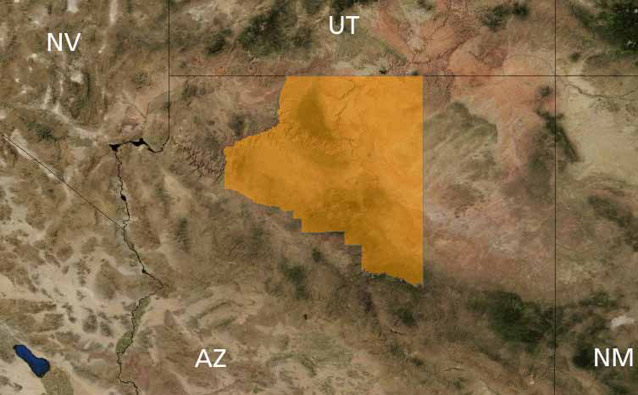Standing guard over the rim of the Grand Canyon, the tiny, federally endangered "sentry" milk-vetch is a perennial herb that forms a one inch tall by eight inch wide mat in shallow pockets of soil on the Kaibab limestone.
Habitat and Ecology

Sentry milk-vetch (Astragalus cremnophylax var. cremnophylax) is known from three populations on the South Rim of Grand Canyon National Park. One of the populations was at a popular overlook site where it was trampled by visitors. In 1990, the park built fences around the plants, which protected them from most trampling. In 2008, the park removed the parking lot at the overlook site and restored it to create more habitat for the sentry milk-vetch. The park plans to introduce greenhouse-grown seeds and plants to this expanded area, but growing the plants outside of their natural habitat has been difficult because of their very specific habitat requirements.
Sentry milk-vetch occurs in shallow soil pockets in the pure white, highly porous sections of Kaibab limestone. It grows on large platforms of limestone within the pinyon-juniper forests on canyon rim. The soil, hydrology, and chemical composition of the bedrock where sentry milk-vetch grows may be unique. As of 2008, an estimated 725 plants were known to exist in the wild.

http://www.fws. gov/species/
Description
Sentry milk-vetch is a perennial that forms mats from one to ten inches in diameter. Its stems are short, creeping, and covered with silvery hairs. The leaves, which are 0.1 to 0.5 inches long, are divided into five to nine minute leaflets. During March through April and September through November, pale purple flowers with white-tipped wings form. The fruits are densely hairy, egg-shaped pods that can remain attached to the plant for months. Seedlings tend to germinate near the parent plant.
Conservation Status and Threats
The U.S. Fish and Wildlife Service has listed sentry milk-vetch as an endangered species since December 5, 1985. Arizona lists it as critically imperiled.
The major threat to this species has been trampling by visitors. By fencing one of the populations and removing the adjacent overlook parking lot, the park has removed that threat, but sentry milk-vetch populations remain vulnerable. Because so few plants exist, the populations are suffering from inbreeding, which is causing seed embryos to abort before seeds can develop. The genetic similarity among the plants, in addition to their specific habitat requirements, also means that the populations may not be able to adapt to future changes, like climate change. Monitoring of the plants since 1988 has shown that many plants die during dry years, partially because of drought stress, but also because rock squirrels dig up the roots.
Related species
Sentry milkvetch is one of three varieties of the species Astragalus cremnophylax. The other two varieties, Marble Canyon milk-vetch (var. hevronii) and cliff milk-vetch (var. myriorrhaphis), occur at other locations in northern Arizona and are larger than sentry milk-vetch.
References
Grand Canyon National Park. 2010. Sentry milk-vetch: endangered plant. Grand Canyon National Park, Grand Canyon, AZ. Available at https://www.nps.gov/ grca/naturescience/astragalus.htm (accessed 21 June 2010).
NatureServe. 2009. Astragalus cremnophylax var. cremnophylax. NatureServe explorer: An online encyclopedia of life. Version 7.1. NatureServe, Arlington, VA. Available at http://www.natureserve. org/explorer/ (accessed 21 June 2010).
U.S. Fish and Wildlife Service. 2006. Sentry milk-vetch (Astragalus cremnophylax var. cremnophylax) recovery plan. U.S. Fish and Wildlife Service, Albuquerque, NM. Available at http://www.fws.gov/ecos/ajax/ docs/recovery_plan/060928.pdf (accessed 21 June 2010).
U.S. Fish and Wildlife Service. 2009. Spotlight species action plan. U.S. Fish and Wildlife Service, Arizona Ecological Services Field Office, Phoenix, AZ. Available at http://www.fws.gov/ecos/ajax/docs/action_ plans/doc3054.pdf (accessed 21 June 2010).
U.S. Fish and Wildlife Service. 2009. 5-Year review: summary and evaluation. Sentry milk-vetch (Astragalus cremnophylax var. cremnophylax). U.S. Fish and Wildlife Service, Arizona Ecological Services Field Office, Phoenix, AZ. Available at: http://www.fws. gov/southwest/es/arizona/Documents/SpeciesDocs/ Sentry/Sentry%20Milk-Vetch%205-Year%20Review. pdf (accessed 22 June 2010).
Prepared by Kelly Reeves, Southern Colorado Plateau Network Inventory and Monitoring Program, 2010.
Last updated: July 1, 2015
